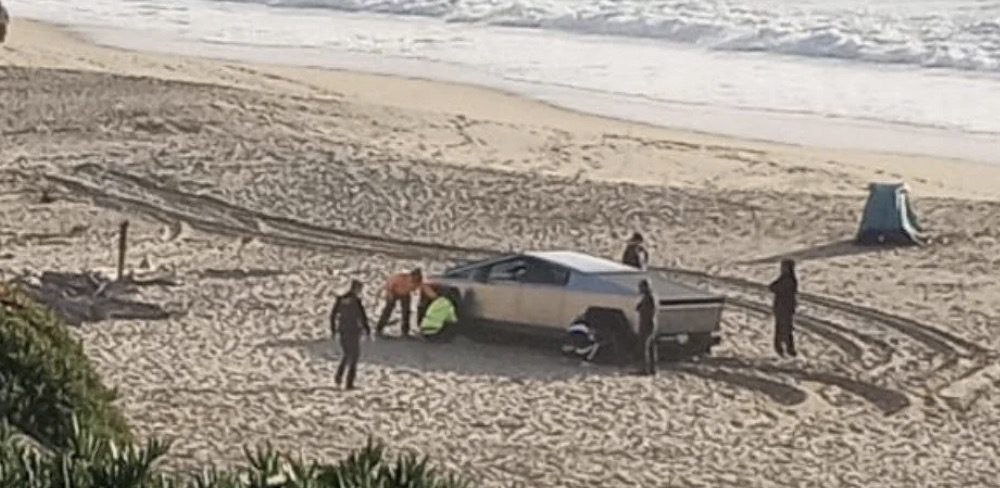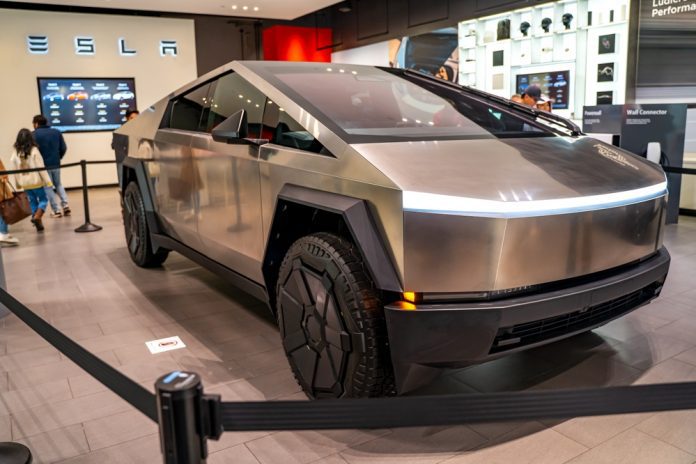Rather than losing charm in the months after its highly-publicized release, the Cybertruck, and its ability to intrigue as much as it confounds, has only grown more hypnotic.
As the few Americans who can find, much less drive, a Cybertruck have attested online, Tesla’s debut entry into the electric pickup market excels in some ways and underperforms in others. While the same can likely be said about a majority of other vehicles, this particular product has the conspicuous distinction of defying development hurdles that far more pragmatic models have succumbed to, releasing after years of delays, broken promises, perplexing design choices, and extensive interference from the man who has pursued micro-management with the same zest an artist does his craft, Elon Musk. So, what has been the typical Cybertruck owner experience since its release?
One of the most notable design elements of the Cybertruck, apart from its brutalist and (for reasons we will discuss later) ironically coffin-esque shape, is its full-body armor comprised of a stainless steel alloy, a material so sturdy that Tesla had to develop an entirely new manufacturing process just to shape it. Although the choice to cover the pickup in a material more commonly seen in the refrigerator aisle at Home Depot has earned it some uncharitable comparisons, most consumers have expressed an openness to the vehicle’s quirky exterior.
Recently, however, some Cybertruck drivers have sounded the alarm over a potential oversight. Tesla customers have taken to online forums and social media to post close-up pictures of their pickup’s steel body, which plainly reveal the early signs of rust forming on the once flawless surface. The automaker has previously acknowledged the issue but says that owners can avoid rusting by regularly cleaning the vehicle, especially after leaving it outside or in the rain.
Given that a major selling point of the Cybertruck was its ability to handle the same off-road punishment as any emissions-belching F-series behemoth, it makes sense that owners would use such a product for road trips, parking outdoors when needed. Bringing cleaning supplies on such ventures would likely be the last thing on anyone’s minds, even if, as one forum poster admitted, they were warned about rusting when purchasing that car.


Screenshot taken by CBS News from cybertruckownersclub.com of photo detailing Cybertruck rust buildup
That being said, buffing out the occasional blemish is hardly an inconvenience for wealthy vehicle owners, a small but notable percentage of whom participate in the expensive but fascinating hobby of antique car collecting. And what Tesla’s alloy lacks in weather resistance, it more than makes up for in its resistance to…well, most everything else.
Many will remember the video of Tesla design chief Franz von Holzhausen planting a metal ball squarely into the bulletproof glass of the Cybertruck’s window with the apparent athleticism and skill of an MLB pitcher. While that incident may or may not have been a fluke, the reputation of the pickup’s metal shell has never suffered much doubt. In a review video (available here) posted February 1, 2024, YouTube channel Throttle House not only repeatedly abused their Cybertruck as they scaled mountainous roads on a road trip to Yosemite National Park but also invited onlookers to kick, stomp, or scrape their vehicle as they pleased. As close-ups revealed, their efforts caused no discernable effect on the ostensibly impenetrable exterior.
More recently, customers at luxury car dealer Vegas Auto Gallery (VAG) were also invited to test their might against the Cybertruck, much as if it were a punching-bag machine tucked in the corner of some dingy carnival. In a video shared by daring astronaut, peace broker, live-streamer, and possible Alex-Jones caller Musk himself, VAG’s clients, wielding complimentary baseball bats, pummeled the pickup with all their might. While their attacks may have lacked the grace of von Holzhausen’s historic, glorious, sound-barrier-breaking pitch, their heroic attempts had no avail upon the indifferent Cybertruck.
Indeed, as Throttle House explained in their review, the Cybertruck’s metal alloy is so sturdy that Tesla just barely managed to bend it into the shape of the front bumper. But while the strength of its exterior is undeniable, not everyone is thrilled to share the road with this new vehicle. In a report published last December, Reuters discussed the Cybertruck’s potential safety issues with experts in the field. For context, vehicles are typically designed with “crumple zones,” areas on the frame that easily distort during a crash to absorb shock and limit transfer to occupants.
Julia Griswold, director of the University of California, Berkeley’s Safe Transportation Research and Education Center, expressed alarm at Tesla’s own crash-test footage, posted by the brand to soothe customer concerns over safety. The heavy weight of the trucks “raise red flags for non-occupants,” she commented. As David Friedman, former National Highway Traffic Safety Administration (NHTSA) chief, put it: “If you’re in a crash with another vehicle that has a crumple zone and your car is more stiff, then their cars are going to crush and yours is resistant.” Musk himself has remarked of the Cybertruck, “If you have an argument with another car, you will win.”
It is important to note that the Cybertruck, in spite of its resilience, does have a crumple zone, along with other shock-absorbing mechanisms. The jury is still out on how dangerous, if it is dangerous at all, it may be. But the concerns expressed by Reuters experts tie into a deeper issue. Tesla has a rather sordid history with regulators and its prioritization of general consumer safety. While many would point to the company’s questionable launch of self-driving software that has yet to clear the beta stage of development as evidence of the limited care they extend to their buyers, a lesser-known instance may better serve that purpose.
Reuters, again in December 2023, published an extensive report examining company messages, reviewing government documents, talking to consumers, and interviewing former Tesla employees. The results of the investigation brought forth evidence it says show that aft-link and fore-link components, affecting suspension and power steering, exhibited “chronic failures” across several Tesla models over the course of multiple years. Arguing that the company should have known the parts were faulty, given the massive amount of records citing the issue, Reuters then cited instances where owners were not only charged for aft-link repairs but also accused of “driver abuse” and “vehicle misuse,” claims that were even offered to the NTSHA as an excuse for why suspension failures were so common in the affected models.
Few major manufacturers, in or outside the U.S., are free from reproach. Even Boeing, the pinnacle of high-quality airplane engineering for many years, has had its reliability called into question in recent months. That being said, Tesla is unique among its peers in the automotive industry, not for being worse, but for being less experienced at handling controversy.
On X, formerly Twitter, a company now owned by Musk, the official Cybertruck account posted a video of the peculiar pickup making its way through Hell’s Revenge, a decidedly non-demonic trail in Utah with perilous terrain, with relative ease. The video is likely in response to a series of other posts that show Cybertruck drivers struggling to overcome less masculine-sounding obstacles, notably snow and sand. To be transparent, it is not clear whether those instances are due to driver error or poor vehicle design. Then again, similar doubts can be cast upon Tesla’s own video, such as whether the model shown was modified for the run.


Photo posted in r/santacruz on Reddit.com showing Cybertruck immobilized on beach
Last November, Musk dismissed concerns over the safety of Tesla’s lineup during a New York Times event. “We make the best cars,” he boasted. “Whether you hate me, like me, or are indifferent, do you want the best, or do you not want the best car?” At this point in time, given the mixed experiences shared online, it seems consumers have yet to decide if they agree with the CEO’s sentiments.




